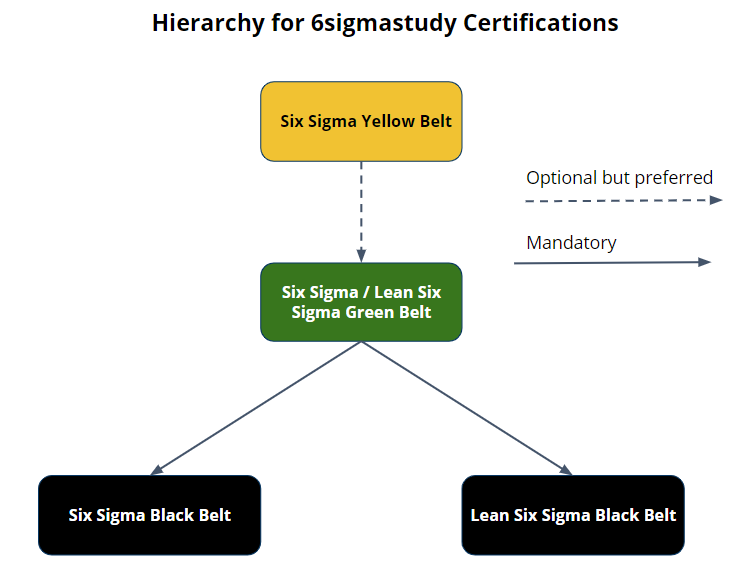Six Sigma Green Belt (SSGB)
Course Features
- Course Duration:
- Category: Six-Sigma – Quality Management
- Students: 0
- Certificate: Yes
- Location:
- Language:
- Lesson: 0
- Viewers: 3288
- Prerequisites: No
- Skill Level: Beginner
- Course Capacity: 280
- Start Course:
Descriptions
Six Sigma Green Belt (SSGB)
Available in 3 different languages, Six Sigma Green Belt course equips students with an understanding of the various Six Sigma tools and techniques useful to improve the production process and minimize defects in the end product with a greater focus on the practical implementation of these tool and techniques in the organization.
It is preferred to have a six sigma yellow belt prior to applying for the Green Belts, but is not mandatory. Employees and organizations requiring a standardized approach to problem solving for the purpose of continuous improvement in Quality Management should opt for this certification.

|
• Introduction to Six Sigma – History of Quality (Deming, Juran, JIT, Ishikawa, Taguchi, etc.) – Evolution of Six Sigma – Defining Six Sigma – philosophy and objectives – Overview of Six Sigma DMAIC process • Stakeholders & Setting up a Six Sigma Project – Identifying and Documenting stakeholder requirements o Identifying stakeholders and customers o Data collection and analysis o Determining critical requirements – Project Selection Criteria o Identifying performance metrics o Using Financial criteria to evaluate project benefits o Maximizing project benefits for the organization – Project Planning o Creating Project Charter o Charter Negotiation – Managing Team Dynamics o Initiating teams o Stages of team evolution o Maslow’s hierarchy of needs o Motivation Techniques o Conflict Resolution Techniques o Management / Leadership styles o Roles played by people in a project – Important project management & planning tools • Six Sigma Methodology – Define – Inputs – Need for six sigma project, Executive management sponsorship, core team identified – Tools o Organization hierarchy o High level process maps o High level Pareto charts o Idea generation and categorization tools – Outputs o Project charter o Established metrics o Problem statement o Roles & responsibilities • Six Sigma Methodology – Measure – Objectives of Measure Phase – Inputs – the outputs of the Define phase – Tools o Data collection tools and techniques o Measurement scales o Validation techniques (Gauge R & R) o Statistical distributions o Data mining o Run charts o Process map o Stakeholder tools o Process costs |
– Outputs o Well defined processes o Baseline process capability o Process parameters affecting CTQs o Cost of poor quality (COPQ) o Measurement system • Six Sigma Methodology – Analyze – Objectives of Analyze Phase – Inputs – outputs of the Measure phase – Tools o Ishikawa diagram o Failure mode and effects analysis o Hypothesis testing o Process capability study – Outputs o Important causes of defects o Special and common causes of variation o DPMO and sigma level • Six Sigma Methodology – Improve – Objectives of Improve Phase – Inputs – outputs of the Analyze phase – Tools o Returns on investment o Solution design matrix o Design of experiment o Taguchi robustness concepts o Response surface methodology o Project planning and management tools o Prototypes – Outputs o Cost / benefit for different solution o Selection of solutions for implementation o Implementation plan • Six Sigma Methodology – Control – Objectives of Control Phase – Inputs – outputs of the Improve phase – Tools o Control plan o Statistical process control o Lean enterprise o 5S o Kaizen o Kanban o Total productive maintenance o Measurement system reanalysis – Outputs o Implemented solutions o Revised measurement system o Control plan for sustaining benefits o Improves process capability o Lessons learned • Case Study – Case Study Part 1 – Case Study Part 2 – Case Study Part 3 |
- Multiple Language Options
- 6 Months Online Access
- Online Self-Paced Learning
- Online Exam Fee Included
- Free Demo Access Available
Audience Profile
Employees and organizations requiring a standardized approach to problem solving for the purpose of continuous improvement in Quality Management.
Prerequisites
Preferably Six Sigma Yellow Belt (But not mandatory)
6sigmastudy Certification Online Exam: System Requirements
- Please note that this is a proctored exam, so you must have a webcam in working condition or you will not be able to take the test. The webcam will remain on during the test, and the video of your exam will be captured throughout the test.
- A working headphone or system microphone to connect to the audio conference.
- This test works with latest versions of Internet Explorer, Google Chrome, Firefox or other popular browsers. Ensure that you have the latest version
Exam Format
- Multiple Choice
- 90 questions per exam
- One mark awarded for every right answer
- No negative marks for wrong answers
- 120 minutes duration
- Proctored online exam
Recertification Process:
- All 6sigmastudy™ certificates till 30th November 2020 will have lifetime validity.
-
Starting 1st December 2020, all 6sigmastudy™ Green Belt and Black Belt certificates will be valid for three years and should be renewed within three calendar years of its issue date.
- To renew a certificate, students need to either take a recertification exam or another 6sigmastudy™certification.
- Recertification exam will be enabled in the online account 6 months before the certificate expiry date.
- Recertification exam has an associated fee and Includes:
- Online course valid for 3 months
- Online un-proctored exam
- Two free exam retakes
Upon passing the certification or recertification exam, students will have all their existing 6sigmastudy™ certifications renewed for an additional 3 years from the date they pass the exam.
